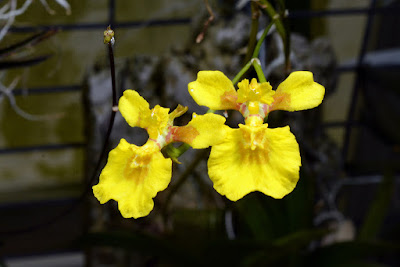Tolumnia urophylla is native to Lesser Antilles. These plants are found in the northern half of the archipelago, on the islands of Antigua, St. Barthelemy, St. Eustatius, Saba, Montserrat, Barbuda, Guadeloupe and Dominica...
Tolumnia urophylla also called as The Tail-Like Leaf Tolumnia, Oncidium urophyllum, Oncidium urophyllum f. flavum, is a species of the genus Tolumnia. This species was described by Guido Jozef Braem in 1986.
IDENTIFY TOLUMNIA UROPHYLLA
Tolumnia urophylla is native to Lesser Antilles. These plants are found in the northern half of the archipelago, on the islands of Antigua, St. Barthelemy, St. Eustatius, Saba, Montserrat, Barbuda, Guadeloupe and Dominica. They grow there on bushes at low altitudes, often very close to the beaches.
It is a miniature, hot to cool growing, fan shaped, twig epiphytic species, which reaching up to 30 diameters, with a fan of linear-ligulate, up to 15 cm long leaves.
The Tail-Like Leaf Tolumnia blooms in the spring, summer and autumn on a lateral, erect, slender, terete, 90 cm long, raceme or few branched panicle that is laxly several flowered and has a tendency to make many keikis. The flowers are up to 2.5 cm across the wide-spread center of the lip and almost the same length if measured from the top of the dorsolateral to the end of the lip. The flowers are yellow with small reddish-brown spots on the petals of the inner whorl and at the base of the lip.
TOLUMNIA UROPHYLLA CARE AND CULTURE
Cultural information should only be used as a guide, and should be to be adapted to suit you. Your physical location; where you grow your plants, how much time you have to devote to their care, and many other factors, will need to be taken into account. Only then can you decide on the cultural methods that best suit you and your plants.
Light:
Tolumnia urophylla needs a light level of 20000-3000 lux. These plants require bright, slightly filtered or scattered light and protection against direct effects of the midday sun. Strong air movement should be ensured all the time.
Temperature:
The average temperature of the summer day is 29-30 ° C, the night 25 ° C, and the daily difference is 4-5 ° C. The average temperature of the winter day is 27-28 ° C, night 22-23 ° C, and the daily difference is 5-6 ° C.
Humidity:
For most of the year, The Tail-Like Leaf Tolumnia needs the average humidity of 75-80%, but during the 3 months of winter the dry season drops to 70-75%.
Substrate, growing media and repotting:
Tolumnia urophylla are usually grown on rootstocks made of cork, tree ferns or on hardwood branches. If they are mounted, it is necessary to ensure high humidity and fogging in the summer at least once a day. When growing in small pots, you can use a loose, quickly drying substrate.
Watering:
Precipitation is slight to moderate for most of the year, and the drier season is at the end of winter and early spring. The cultivated plants should often be watered during active growth, but their roots must always dry quickly, and the plants between the waterings must be completely dry.
Fertilizer:
Weekly application of 1/4-1/2 of the recommended dose of orchid fertilizer during active growth is recommended. From spring to mid-summer, high-nitrogen fertilizer should be used, and then until the end of autumn high-phosphoric fertilizer.
Rest period:
In winter, the amount of water to Tolumnia urophylla should be reduced, but it can not be completely dry for too long. Fertilization should be reduced or eliminated until spring, when new growths appear and more watering begins.















COMMENTS